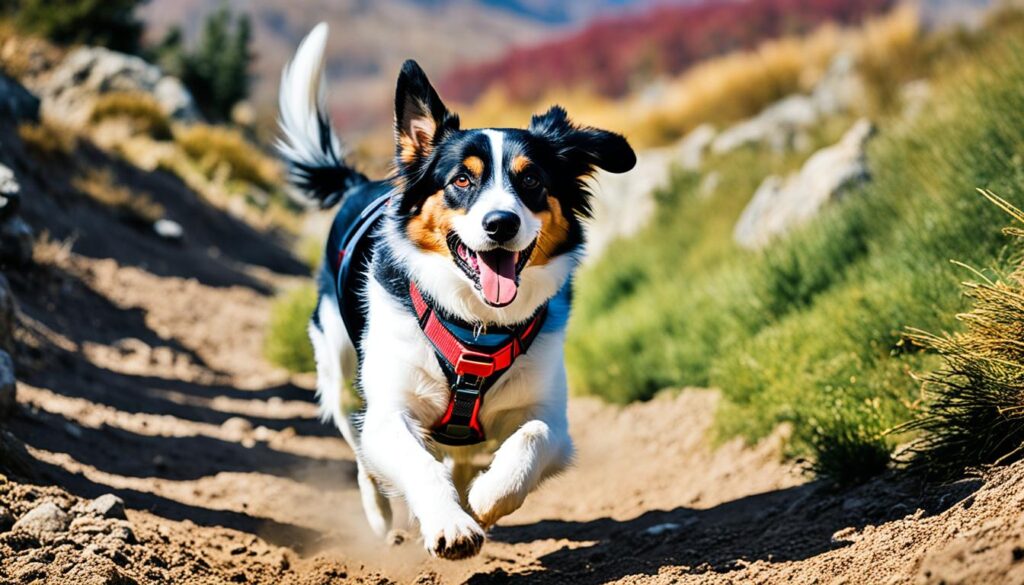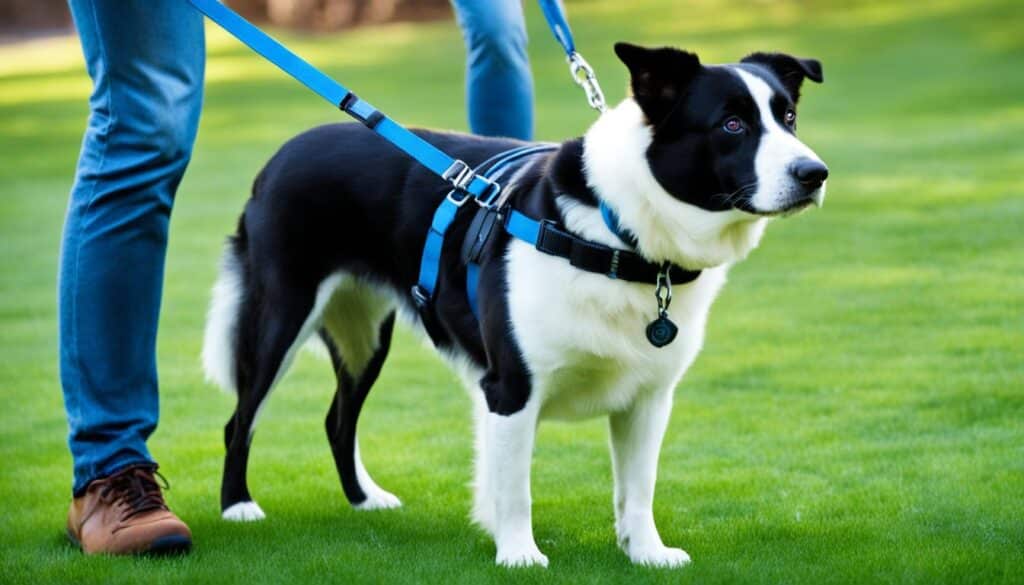Leash training is an essential skill for every dog owner. However, not all dogs are the same, and a one-size-fits-all approach doesn’t work regarding leash training. To successfully train your furry friend, you must understand their unique personality and tailor your training techniques accordingly. In this guide, we will provide you with personalized leash training tips and strategies for different dog personalities.

Whether you have an energetic dog, an anxious dog, a stubborn dog, a small dog, or a big dog, we have got you covered. By understanding your dog’s personality traits and characteristics, you can implement effective leash training strategies to make your walks enjoyable for both of you.
Key Takeaways:
- Leash training is not a one-size-fits-all approach.
- Understanding your dog’s unique personality is crucial for successful training.
- Different dog personalities require different leash training techniques.
- Energetic dogs may need shorter, engaging training sessions with high-value rewards.
- Anxious dogs may benefit from gradual exposure, patience, and positive reinforcement.
- Stubborn dogs may require consistency, positive reinforcement, and redirection techniques.
- Small dogs and big dogs each have their specific challenges and training needs.
Understanding Your Dog’s Personality
Every dog has a unique personality that impacts their training needs and behavior regarding leash training. Understanding your dog’s personality is critical to tailoring effective leash training techniques catering to their traits and tendencies. In this section, we will explore different types of dog personalities and their characteristics, helping you identify which category your furry friend falls into.
The Eager Explorer: Dogs bursting with energy, easily distracted

The Eager Explorer is characterized by their boundless energy and curiosity. These dogs are always eager to explore their surroundings and can easily get distracted by new scents, sounds, and sights. Leash training for eager explorers requires patience, consistency, and engaging techniques to keep their focus. Short and engaging training sessions, high-value rewards, and starting in quiet areas can help channel their energy and minimize distractions during walks.
The Timid Pup: Shy dogs, cautious of new surroundings
The Timid Pup is often cautious and easily overwhelmed by new environments and experiences. These shy dogs may hesitate or show signs of anxiety during leash training. For leash training timid pups, gradual exposure is critical. Start in familiar spaces where they feel comfortable and gradually introduce them to new surroundings. Patience, positive reinforcement, and a calm and reassuring environment will help build their confidence and make leash training a positive experience.
The Stubborn Streak: Independent, strong-willed dogs

Their independent and strong-willed nature characterizes the Stubborn Streak. These dogs have a mind and may challenge authority during leash training. Consistency, positive reinforcement, and establishing clear boundaries are essential to train stubborn dogs successfully. Employing redirection techniques, using high-value rewards, and considering professional help can help you overcome challenges and build a cooperative leash-walking routine with your independent companion.
The Social Butterfly: Always seeking attention and interaction
The Social Butterfly is a dog that craves attention and interaction from its humans and other dogs. These dogs are highly social and may get easily distracted by people or other animals during walks. Leash training for social butterflies requires teaching them to focus on you amidst all the distractions. Incorporating the “look at me” command, structured walks to manage distractions, and rewarding calm behavior around others are techniques that can help you achieve a harmonious and enjoyable leash-walking experience with your attention-seeking companion.
The Basics of Leash Training
To successfully train your dog, it is essential to understand the basics of leash training. This section will give you the knowledge and techniques to start on the right path.
Equipment Essentials: Choosing the proper collar/harness and leash
Regarding leash training, selecting the right equipment for your dog is crucial for their comfort and safety. Here are some considerations to keep in mind:
- Collar or Harness: Choose a collar or harness that fits your dog correctly and does not restrict their movement. Consider your dog’s size, breed, and any special needs they may have.
- Leash Length: Determine the appropriate leash length based on the training goals and your dog’s behavior. A shorter leash allows for more control, while a longer leash provides more freedom.
- Material and Design: Opt for a durable and comfortable material, such as nylon or leather, suitable for your dog’s size and strength. Additionally, features like reflective strips should be considered for increased visibility during walks at night.
Choosing the suitable collar, harness, and leash will ensure your dog is comfortable and secure during training sessions.
Introducing the Leash: Positive association techniques
Introducing the leash to your dog positively and gradually is essential for building a solid association and reducing anxiety or resistance. Follow these steps to introduce the leash:
- Let your dog sniff and investigate the leash without any pressure or restraint.
- Gradually attach the leash to your dog’s collar or harness while providing treats and praise.
- Allow your dog to move freely with the leash attached, rewarding calm and relaxed behavior.
- Practice short periods of supervised leash time in a familiar and low-distraction environment.
By using positive reinforcement techniques, your dog will soon associate the leash with positive experiences, making future training sessions more effective.
The Fundamentals of Loose Leash Walking:
One of the critical goals of leash training is teaching your dog to walk calmly on a loose leash. Here are the fundamentals of loose-leash walking:
- Focus Training: Teach your dog to focus on you using cues such as “look at me” or “watch me.” Reward and praise your dog for maintaining eye contact.
- Proper Positioning: Encourage your dog to walk on a loose leash beside you. Use verbal cues and treats to guide them into the desired position.
- Rewarding Good Behavior: Reward your dog for walking calmly on a loose leash. Offer treats, praise, or playtime as positive reinforcement for their excellent behavior.
Consistency, patience, and positive reinforcement are key when teaching your dog loose-leash walking. With practice, your dog will learn to walk politely beside you, making walks enjoyable for both of you.
Tailoring Leash Training to Personality
The Eager Explorer:
For the energetic and easily distracted eager explorer, it’s essential to keep training sessions short and engaging. These dogs thrive on variety and mental stimulation, so consider incorporating different activities into the training routine. Use high-value rewards like small treats or toys to capture their attention and motivation. Start training in quiet areas with fewer distractions, gradually increasing distractions as they become more reliable on the leash. This approach will help channel their energy and focus during walks.
The Timid Pup:
Timid pups require a gentle and patient approach to leash training. Start in familiar and comfortable environments, like your backyard or a quiet park, where they can build confidence at their own pace. Gradually expose them to new surroundings, introducing them to different sounds, sights, and smells one step at a time. Use plenty of positive reinforcement, such as treats and praise, to boost their confidence and motivate them during training. Remember to be patient and understand that it may take longer for timid pups to adjust to leash walking.
The Stubborn Streak:
Stubborn dogs with strong-willed personalities require consistent and positive reinforcement during leash training. Establish clear rules and boundaries and be firm but fair in your approach. Use positive reinforcement techniques, such as treats and praise, to reward good behavior and motivate them to comply with leash commands. Employ redirection techniques, such as changing direction or using favorite toys, to redirect their attention and prevent stubborn behaviors. If you’re facing challenges with a stubborn streak, don’t hesitate to seek the guidance of a professional dog trainer who can provide specialized training techniques.
The Social Butterfly:
Social butterflies always seek attention and interaction, and they benefit from leash training techniques that enhance their focus and impulse control. Teach them a “look at me” command to redirect their attention to you during walks. Practice structured walks where they learn to manage distractions and maintain calm behavior around other people and animals. Reward moments of calmness with treats and praise to reinforce desired behavior. With consistent training, social butterflies can learn to balance their outgoing nature with leash manners.
By tailoring leash training to your dog’s unique personality, you can effectively address their needs and ensure a successful leash walking experience. Whether your dog is an eager explorer, a timid pup, a stubborn streak, or a social butterfly, applying the appropriate techniques, such as short, engaging sessions, gradual exposure, consistency, and positive reinforcement, will help them develop good leash manners. Remember, if you encounter difficulties or feel overwhelmed, don’t hesitate to seek the assistance of a professional dog trainer with expertise in tailoring leash training to different personalities.
Conclusion
In conclusion, leash training is not a one-size-fits-all approach. Understanding your dog’s unique personality is the key to successful training. By tailoring your training techniques to suit your dog’s needs, you can ensure that leash walking becomes a positive and enjoyable experience for you and your furry friend.
Throughout this guide, we explored different dog personalities and provided personalized leash training techniques for each type; for eager explorers bursting with energy, short, engaging sessions and high-value rewards work wonders. Timid pups benefit from gradual exposure, lots of patience, and positive reinforcement. Stubborn streaks require consistency, positive reinforcement, and redirection techniques. Social butterflies respond well to “look at me” focus training and structured walks to manage distractions.
While leash training can sometimes present challenges, such as pulling or leash reactivity, we discussed troubleshooting techniques to help overcome these issues. Remember, consistent practice and positive reinforcement are critical. In advanced training, we covered teaching “heel,” off-leash reliability (when safe and appropriate) and incorporating leash training into fun activities to keep your dog engaged and mentally stimulated.
Following the personalized techniques outlined in this guide and being patient can transform your dog into a well-trained leash walker. Take the time to understand your dog’s personality and adjust your training methods accordingly. With dedication and consistency, you’ll soon enjoy pleasant and calmlyl leash walks with your canine companion.
FAQ
Is leash training the same for all dog personalities?
No, leash training should be tailored to your dog’s unique personality. Understanding your dog’s personality is crucial for successful training.
How do I identify my dog’s personality type?
Pay attention to your dog’s behaviors and traits. Eager explorers are energetic and easily distracted, timid pups are shy and cautious, stubborn streaks are independent and strong-willed, and social butterflies always seek attention and interaction.
What are the basics of leash training?
Start by choosing the suitable collar, harness, and leash for your dog’s comfort and safety. Introduce the leash using positive association techniques and teach loose leash walking by focusing on proper positioning and rewarding good behavior.
How can I tailor leash training to my dog’s personality?
For eager explorers, engage in short training sessions with high-value rewards and start in quiet areas. For timid pups, provide gradual exposure and plenty of patience. For stubborn streaks, emphasize consistency and positive reinforcement, and consider professional help if needed. For social butterflies, practice focus training and reward calm behavior around others.
What should I do if my dog pulls on the leash?
You can use the stop-and-go or change-direction technique to address pulling. These techniques involve interrupting your dog’s forward movement when they pull and rewarding them when they walk nicely on a loose leash.
How do I manage my dog’s lunging on the leash?
Create distance from triggers that cause your dog to lunge, and redirect their attention to an alternative behavior. It’s important to teach your dog to focus on you and to reward calm behavior around the triggers.
What should I do if my dog shows leash reactivity?
Leash reactivity requires behavior modification techniques. Seek professional guidance from a certified dog trainer or behaviorist who can help you address the underlying issues and develop a training plan specific to your dog’s needs.
Are there advanced tips for leash training?
Once the basics are mastered, you can teach your dog the command “heel” for precise walking. You can also work on off-leash reliability when it is safe and appropriate. Additionally, consider incorporating leash training into fun activities like agility courses or scent work to keep your dog engaged and challenged.

